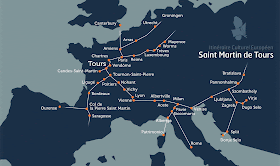June 12 – July 4, 2024
A small group of American pilgrims has embarked on a transformative journey along the Saint Martin Loop, a foot pilgrimage through the heart of France, from the historic city of Tours to the revered Cathedral Saint-Gatien by way of the Abbey Saint Martin in Liguge. From June 12 to July 4, 2024, join us as we explore the life, history, and culture of Saint Martin of Tours, a revered figure in Christian tradition.

- Le Chemin de l’Évêque de Tours: La basilique Saint-Martin in Tours to Poitiers (10 days, 192 km, 13-22 June 2024) +
- Le Chemin de Ligugé: Poitiers to Candes-Saint-Martin (8 days, 138 km, 23-30 June 2024) +
- L’été de Saint-Martin: Candes to the Cathedral Saint-Gatien (3 days, 60 km, 1-4 July 2024)
The Society of Servant Pilgrims has organized an opportunity for American pilgrims to embrace the long-established pilgrim tradition and make a contemplative journey by foot in the small region of France where Saint Martin spent most of the last 36 years of his life, evangelizing the rural communities while serving as abbot of Marmoutiers and bishop of Tours. Our pilgrimage retraces his footsteps, immersing us in the rich tapestry of history and culture that shaped his legacy.
 The pilgrimage route combines three existing, traditional, and well-marked pilgrim paths to encounter the life and history of St Martin between Poitier and Tours – places well visited by Martin himself in the second half of the fourth century. This ‘grande boucle’ begins at the Basilica in Tours, follows the ‘Bishop’s Path’ to Ligugé, then, passing through Poitiers, it continues to Candes-Saint-Martin, where he died, along the ‘Ligugé Path,’ and finally returns to Tours on the ‘Summer of St Martin’ Path that is said to have flowered in November when his body was transported back to Tours.
The pilgrimage route combines three existing, traditional, and well-marked pilgrim paths to encounter the life and history of St Martin between Poitier and Tours – places well visited by Martin himself in the second half of the fourth century. This ‘grande boucle’ begins at the Basilica in Tours, follows the ‘Bishop’s Path’ to Ligugé, then, passing through Poitiers, it continues to Candes-Saint-Martin, where he died, along the ‘Ligugé Path,’ and finally returns to Tours on the ‘Summer of St Martin’ Path that is said to have flowered in November when his body was transported back to Tours.
Through the Loire River Valley, the pilgrimage passes through 4 (of the 300+) towns in France named for St Martin, passes numerous chateaux and vineyards, several village churches founded by St Martin, portions of Roman roads and structures, and crosses in front of many troglodytes – cave dwellings inhabited since prehistoric times.
Who Was Saint Martin?
![]()
 Saint Martin of Tours, born in the 4th century in what is now Hungary, exemplified a life of profound moral character and spiritual dedication. Raised in a pagan household, Martin’s early years were marked by a sense of duty and service, leading him to join the Roman army as a young man. However, it was during his military service that he encountered a beggar on a cold winter’s day, an encounter that would shape the rest of his life. Moved by compassion, Martin divided his cloak in two, sharing it with the beggar. That night, he experienced a vision in which Christ appeared wearing the half-cloak, affirming Martin’s act of kindness and signaling his future conversion to Christianity.
Saint Martin of Tours, born in the 4th century in what is now Hungary, exemplified a life of profound moral character and spiritual dedication. Raised in a pagan household, Martin’s early years were marked by a sense of duty and service, leading him to join the Roman army as a young man. However, it was during his military service that he encountered a beggar on a cold winter’s day, an encounter that would shape the rest of his life. Moved by compassion, Martin divided his cloak in two, sharing it with the beggar. That night, he experienced a vision in which Christ appeared wearing the half-cloak, affirming Martin’s act of kindness and signaling his future conversion to Christianity.
Following his baptism, Martin embarked on a journey of spiritual exploration and service. Renouncing his military career, he became a disciple of Hilary of Poitiers and embraced a life of asceticism and prayer. Founding the first monastery in Gaul at Ligugé, Martin embodied the virtues of humility, compassion, and selflessness. Despite his reluctance, he was eventually called to serve as Bishop of Tours, where he continued to lead a life of simplicity and devotion, prioritizing the needs of the poor and marginalized.
Throughout his life, Saint Martin’s actions were guided by a deep commitment to compassion and social justice. He was known for his humility and his willingness to serve others, regardless of their social status or background. From his legendary act of sharing his cloak with a beggar to his tireless efforts to evangelize and care for the needy, Martin’s life serves as a testament to the transformative power of love and kindness. His legacy continues to inspire countless individuals to this day, reminding us of the profound impact that one person’s good moral character can have on the world.
Saint Martin was sanctified by his life, not his death, being the first to be named “Saint” without having been martyred. Those who knew him, knew that the way he lived his life of heroic virtue made him worthy to be titled Saint immediately upon his death. Pilgrims began to flock to his tomb and have never stopped. Centuries later, pilgrims making their way to Santiago de Compostela and Mont Saint Michel would go by way of the tomb-shrine of Saint Martin. Kings and crusaders came to venerate him before their dangerous undertaking.
The formation of modern Europe cannot be solely attributed to the actions of Saint Martin, but his influence certainly played a significant role in shaping the cultural, social, and religious landscape of the continent through his tireless efforts in spreading Christianity, promoting social justice, and fostering cultural unity. As Bishop of Tours, he played a pivotal role in the evangelization of Gaul and beyond, establishing churches and monasteries and bringing comfort to the masses through the sharing of his Christian principles. His commitment to social justice and compassion for the poor set a powerful example, influencing the development of welfare systems and humanitarian values across Europe.
Moreover, Saint Martin’s legacy as a promoter of monasticism contributed to the intellectual and cultural advancement of medieval Europe. By founding the first monastery in Gaul (Ligugé) and encouraging the monastic lifestyle, he laid the groundwork for the preservation and transmission of knowledge, as well as the flourishing of artistic creativity. His influence extended far beyond his lifetime, shaping the religious, social, and cultural landscape of Europe and contributing to the emergence of a shared European identity. Saint Benedict of Nursia greatly admired Saint Martin for his humility, charity, and devotion to God. Benedict frequently referenced Saint Martin as a model of these virtues in his Rule, emphasizing simplicity of life, care for the needy, and the pursuit of humility. Saint Martin’s influence on Benedict’s spiritual journey is evident in the principles of monastic life outlined in the Rule, which prioritize obedience, humility, and communal living. Through his example, Saint Martin played a foundational role in shaping the Benedictine monastic tradition and the establishment of Western monasteries.
What is the Via Sancti Martini?
The Via Sancti Martini is a network dedicated to Saint Martin in Europe. In total, it comprises a series of routes that traverse various countries, connecting sites associated with the life and legacy of Saint Martin of Tours. These trails are part of the broader European network of pilgrimage routes and are marked by historical significance and cultural heritage.
In France, the Chemin de Saint-Martin is a well-established pilgrimage route that traces the footsteps of Saint Martin from Tours to the shrine of Saint Martin de Ligugé, passing through towns, villages, and religious sites linked to his life and ministry. This route is popular among pilgrims seeking spiritual enrichment and historical insight into the saint’s profound influence on the region.
Beyond France, Saint Martin pilgrimage routes extend into neighboring countries such as Germany, Belgium, and the Netherlands, where Saint Martin is also venerated. These routes often intersect with other major pilgrimage trails, such as the Camino de Santiago and the Via Francigena, creating a network of spiritual pathways that crisscross Europe.
Each pilgrimage route offers pilgrims a unique opportunity to connect with Saint Martin’s legacy, whether through visits to churches dedicated to him, encounters with local communities, or moments of reflection in the natural landscapes he once traversed. By following in Saint Martin’s footsteps, pilgrims embark on a journey of faith, solidarity, and cultural exchange that transcends borders and unites diverse peoples in a shared quest for meaning and enlightenment.
What is the Society of Servant Pilgrims?
 The Society of Servant Pilgrims is a Catholic Association of the Christian Faithful established in the Archdiocese of Denver, USA under the requirements of canon law 298. With the understanding that ‘love your neighbor as yourself’ is a directive for action, the underlying motive of a Servant Pilgrim is to go out and meet the neighbors of the world, and in so doing, build trust, which is the foundation of peace. The role of the Servant Pilgrim is to travel through the world, village to village, by foot in a demonstration of faith and with the daily effort to engage with people of the world, meeting them where and when they are encountered.
The Society of Servant Pilgrims is a Catholic Association of the Christian Faithful established in the Archdiocese of Denver, USA under the requirements of canon law 298. With the understanding that ‘love your neighbor as yourself’ is a directive for action, the underlying motive of a Servant Pilgrim is to go out and meet the neighbors of the world, and in so doing, build trust, which is the foundation of peace. The role of the Servant Pilgrim is to travel through the world, village to village, by foot in a demonstration of faith and with the daily effort to engage with people of the world, meeting them where and when they are encountered.
Resources:
https://www.coe.int/fr/web/cultural-routes/the-saint-martin-of-tours-route
